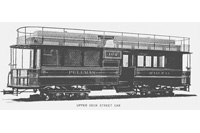Locomotive and Electric Railcar
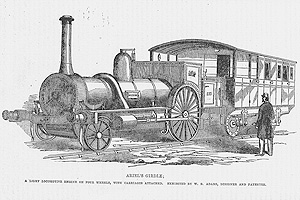 This is an image of a steam locomotive exhibited at the first London International Exposition of 1851. Actually, some 50 years had passed since the first operation of a steam locomotive, with the railroad business already established. Nevertheless, since locomotives were still in progress, they were often exhibited at international expositions.
This is an image of a steam locomotive exhibited at the first London International Exposition of 1851. Actually, some 50 years had passed since the first operation of a steam locomotive, with the railroad business already established. Nevertheless, since locomotives were still in progress, they were often exhibited at international expositions.
The first steam locomotive was operated in 1804. Developed by R. Trevithick of England, it ran on rails for horse-drawn wagons at an ironworks. It comprised a cast-metal cylindrical boiler mounted on a four-wheel frame. The boiler was so heavy that the rails were destroyed, making it difficult to put the locomotive into practical use. However, with the increase of transportation demand with the progress of the Industrial Revolution, horses for industrial use were requisitioned for the Napoleonic Wars, causing the value of a steam locomotive to be recognized anew.
The steam locomotive built in 1812 by J. Blenkinsop was used in mines for 23 years. In 1825, G. Stephenson created the Locomotion, which hauled a 90-ton train on a public railroad that had been used for the first time in the world for the operation of steam locomotives. For the rails, the use of wrought iron, which just started to become available in those days, increased the strength, paving the way for the full development of a railroad network.
In 1829, the Rocket of Stephenson Co. ran at 40 kilometers per hour, and won a competition held by the Liverpool & Manchester Railway. Featuring a mechanism of directly conveying the force brought by a piston to the wheels, it set the standard for subsequent steam locomotives. In 1830, the world's first passenger transportation began.
Steam locomotive spread from the United Kingdom to the world. In the middle 1830s, however, such locomotives began to be imported from the United States into the United Kingdom. In the United States, a vast country, locomotives were developed as a means of transportation. In 1869, it became possible to travel across the continent from east to west by railroad. Many steam locomotives made in the United States were exhibited at international expositions.
In and after the 1830s, efforts were made in the use of electricity as a motive power. In 1879, Siemens' small-sized direct current electric locomotive was operated at the Berlin Industrial Exhibition. It is said that this was the first practical electric railroad, with electricity supplied from overhead wires or third rails. In 1899, a three-phase alternating current electric railcar (passenger and freight cars with a motor) was operated in a mountainous region in Switzerland. In 1903, Siemens-AEG's test electric railcar successfully marked a velocity exceeding 200 kilometers per hour. Around that time, streetcars came into wide use. In 1905, due to the development of single-phase alternating current, which enabled the supply of electricity only with a single wire, the electrification of railroads was further promoted. More and more electric railcars gradually came to be exhibited at international expositions.
At the end of the 19th century, the use of Diesel power began to be discussed, with consideration given to the lack of need for overhead wires, the ease of establishment of railroad lines, a large hauling capacity, high thermal efficiency, and other merits. Also, around that time, the electrification of subways also began.
Steam Locomotive (19 images)
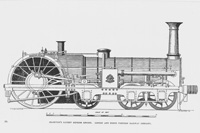 |
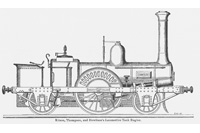 |
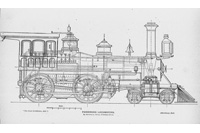 |
| Folkstone, Steam Locomotive for Which Patent Was Obtained by Thomas R. Crampton | Kitson, Thompson & Hewitson's Tank Locomotive | Design Drawing of Baldwin's Steam Locomotive |
Telegraph (7 images)
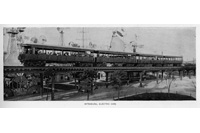 |
 |
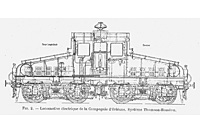 |
| Electric Railcar on the Elevated Railroad | Edison's Electric Railcar Motor | Electric Locomotive |
- References:
Coiley, John; Eikoku kokuritsu tetsudo hakubutsukan (supervise).: Sekai no tetsudo jiten (Asunaro shobo, 2008) <NC34-J8>
Mizushima, Toru.: Joki kikansha tanjo monogatari (Guranpuri shuppan, 2004) <NC34-H76>
Ross, David ; Koike, Shigeru, Wakuda, Yasuo (tr).: Sekai tetsudo hyakka zukan: Joki, dizeru, denki no kikansha, ressha no subete: 1825nen kara gendai (Yushokan, 2007) <NC2-H21>
Saito, Akira.: Joki kikansha no gijutsushi (Kotu kenkyu kyokai, 2009) <NC34-J24>

